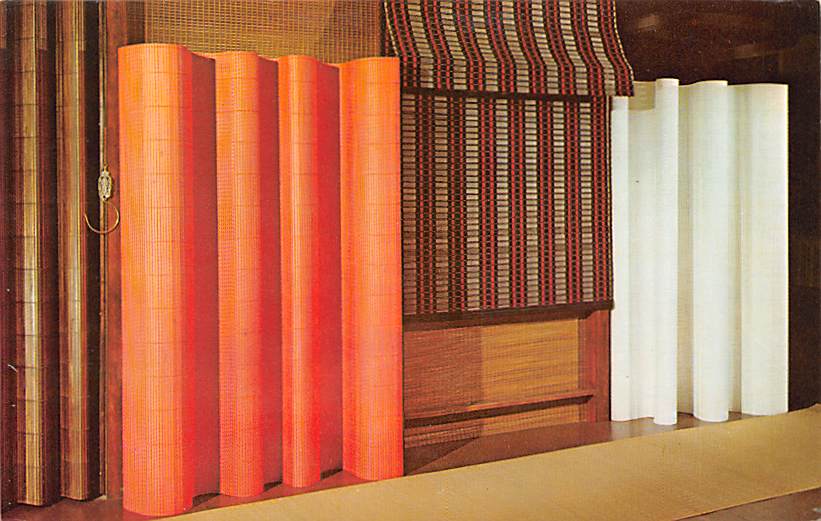 Modern lore, auctions and dealers abound would say Maria Kipp textiles were used in this Paul Laszlo interior.
Modern lore, auctions and dealers abound would say Maria Kipp textiles were used in this Paul Laszlo interior.
Photo: Julius Shulman
 Google would also lead you to believe that Maria Kipp did the lampshades.
Google would also lead you to believe that Maria Kipp did the lampshades.

Auctions too
Source: Orange Hat Auction
 The lamp is surely Laszlo. The problem is the shade most likely isn't by Maria Kipp.
The lamp is surely Laszlo. The problem is the shade most likely isn't by Maria Kipp.
Source: Orange Hat Auction

As we can see here in this 1953 Architectural Digest photo of a Paul Laszlo interior, it was William Webb and not Maria Kipp who provided the drapes and lampshades.
Source: Architectural Digest

Laszlo incorporated a lot of Webb Textiles into his projects, as seen here in the Ohrbach residence in Beverly Hills. These drapes were electrically controlled.
 Apparently, Webb was THE stick weave guy.
Apparently, Webb was THE stick weave guy.
Source: LA Times

 William Webb and his brother Robert operated William Webb Textiles Inc. out of a Pasadena studio located on West Union St. Founded in 1946, the brothers started by selling looms and would teach their customers how to use them. This transitioned into dying yarns, creating their own techniques and fabrics that serviced the exclusive decorator trade.
William Webb and his brother Robert operated William Webb Textiles Inc. out of a Pasadena studio located on West Union St. Founded in 1946, the brothers started by selling looms and would teach their customers how to use them. This transitioned into dying yarns, creating their own techniques and fabrics that serviced the exclusive decorator trade.
William in his studio
I found a lot of examples from William Webb textiles that match what was believed to be Kipp textiles. I could not find a single example or even a mention of Kipp using stick weave or even doing lampshades.
I knew about William Webb but never went down the wormhole until someone asked me if I had any documentation after I hashtagged this bathroom set as Maria Kipp.
Busted!
The trashcan has this label inside. It certainly doesn't look like William's silhouette, so you might understand the confusion ;)
Kipp and Webb were contemporaries in Los Angeles who both worked directly with architects and decorators.
Yes, this articles has esoteric in it twice.
Source: LA Times
Kipp had a very successful weaving business that started in the mid-1920's and lasted until 1996, although she retired in 1977. This was her studio, starting in 1951. I'm really curious about the architect. She worked with Paul Revere Williams, Richard Neutra, RM Schindler and a host of other great ones. It's
documented that she hired Schindler to remodel a previous studio at 1773 Griffith Park Blvd. in 1934.
Photo: Julius Shulman © J. Paul Getty Trust. Getty Research Institute, Los Angeles
BTW, the building is still there and looks well cared for.
Source: Google Maps
Kipp and Webb were both featured in this California Design 8 (1962).
In this catalog vignette, a hand-loomed textile on the left is by Kipp and on the right by Webb.
So is the case closed? Are all these stick weave shades by William Webb?
Not so fast. Enter in the San Francisco-based Tropicraft.
Source: Tropicraft advertising postcard
Source: Progressive Architecture, 1956
Source: Furniture Forum, 1955
I thought this was going to be easy and Webb would get all the credit for the shades. I'm sure there must be a way to differentiate between Webb, Tropicraft and others who may have been doing this style of weaving. I have some thoughts but I think all I really proved at this point is that the shades are not by Maria Kipp.
Add Frank Lloyd Wright's favorite weaver, Dorothy Liebes, to the stick weave list. This was part of her Textile Samples (window screens/blinds), circa 1930-circa 1970 at The Smithsonian. It's plausible that they could have also been used on lampshades although I didn't come across any mention of them in the files. Thanks to Steven Keylon for pointing me in the direction of her archive!
Update: I found a photo of a Liebes steak weave shade after going to the Cooper Hewitt exhibition and digging deeper into the archive.
Here's another sample by Liebes

 Google would also lead you to believe that Maria Kipp did the lampshades.
Google would also lead you to believe that Maria Kipp did the lampshades. The lamp is surely Laszlo. The problem is the shade most likely isn't by Maria Kipp.
The lamp is surely Laszlo. The problem is the shade most likely isn't by Maria Kipp. 
 William Webb and his brother Robert operated William Webb Textiles Inc. out of a Pasadena studio located on West Union St. Founded in 1946, the brothers started by selling looms and would teach their customers how to use them. This transitioned into dying yarns, creating their own techniques and fabrics that serviced the exclusive decorator trade.
William Webb and his brother Robert operated William Webb Textiles Inc. out of a Pasadena studio located on West Union St. Founded in 1946, the brothers started by selling looms and would teach their customers how to use them. This transitioned into dying yarns, creating their own techniques and fabrics that serviced the exclusive decorator trade.








%20copy.jpg)
.png)


.jpg)






